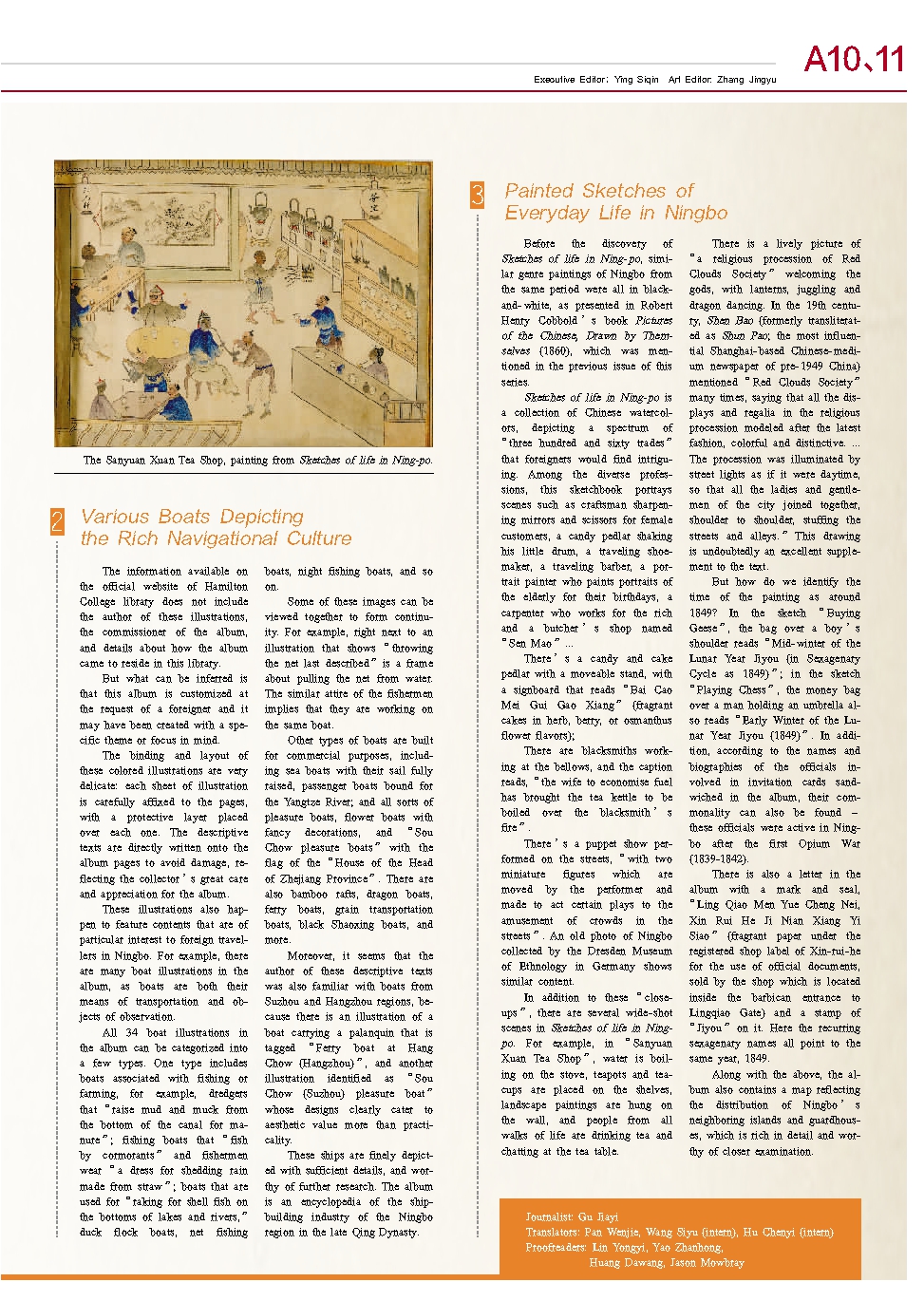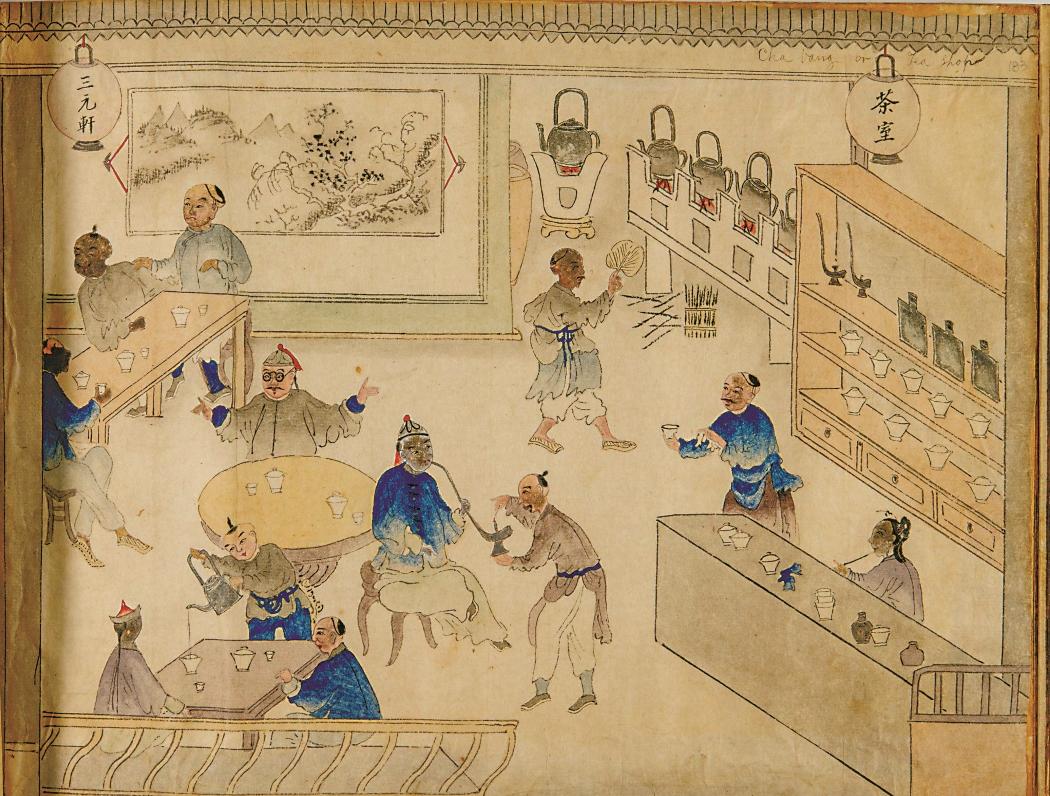Various Boats Depicting
the Rich Navigational Culture
The information available on the official website of Hamilton College library does not include the author of these illustrations, the commissioner of the album, and details about how the album came to reside in this library.
But what can be inferred is that this album is customized at the request of a foreigner and it may have been created with a specific theme or focus in mind.
The binding and layout of these colored illustrations are very delicate: each sheet of illustration is carefully affixed to the pages, with a protective layer placed over each one. The descriptive texts are directly written onto the album pages to avoid damage, reflecting the collector’s great care and appreciation for the album.
These illustrations also happen to feature contents that are of particular interest to foreign travellers in Ningbo. For example, there are many boat illustrations in the album, as boats are both their means of transportation and objects of observation.
All 34 boat illustrations in the album can be categorized into a few types. One type includes boats associated with fishing or farming, for example, dredgers that “raise mud and muck from the bottom of the canal for manure”; fishing boats that “fish by cormorants” and fishermen wear “a dress for shedding rain made from straw”; boats that are used for “raking for shell fish on the bottoms of lakes and rivers,” duck flock boats, net fishing boats, night fishing boats, and so on.
Some of these images can be viewed together to form continuity. For example, right next to an illustration that shows “throwing the net last described” is a frame about pulling the net from water. The similar attire of the fishermen implies that they are working on the same boat.
Other types of boats are built for commercial purposes, including sea boats with their sail fully raised, passenger boats bound for the Yangtze River; and all sorts of pleasure boats, flower boats with fancy decorations, and “Sou Chow pleasure boats” with the flag of the “House of the Head of Zhejiang Province”. There are also bamboo rafts, dragon boats, ferry boats, grain transportation boats, black Shaoxing boats, and more.
Moreover, it seems that the author of these descriptive texts was also familiar with boats from Suzhou and Hangzhou regions, because there is an illustration of a boat carrying a palanquin that is tagged “Ferry boat at Hang Chow (Hangzhou)”, and another illustration identified as “Sou Chow (Suzhou) pleasure boat” whose designs clearly cater to aesthetic value more than practicality.
These ships are finely depicted with sufficient details, and worthy of further research. The album is an encyclopedia of the shipbuilding industry of the Ningbo region in the late Qing Dynasty.
Painted Sketches of
Everyday Life in Ningbo
Before the discovery of Sketches of life in Ning-po, similar genre paintings of Ningbo from the same period were all in black-and-white, as presented in Robert Henry Cobbold’s book Pictures of the Chinese, Drawn by Themselves (1860), which was mentioned in the previous issue of this series.
Sketches of life in Ning-po is a collection of Chinese watercolors, depicting a spectrum of “three hundred and sixty trades” that foreigners would find intriguing. Among the diverse professions, this sketchbook portrays scenes such as craftsman sharpening mirrors and scissors for female customers, a candy pedlar shaking his little drum, a traveling shoemaker, a traveling barber, a portrait painter who paints portraits of the elderly for their birthdays, a carpenter who works for the rich and a butcher’s shop named “Sen Mao” ...
There’s a candy and cake pedlar with a moveable stand, with a signboard that reads “Bai Cao Mei Gui Gao Xiang” (fragrant cakes in herb, berry, or osmanthus flower flavors);
There are blacksmiths working at the bellows, and the caption reads, “the wife to economise fuel has brought the tea kettle to be boiled over the blacksmith’s fire”.
There’s a puppet show performed on the streets, “with two miniature figures which are moved by the performer and made to act certain plays to the amusement of crowds in the streets”. An old photo of Ningbo collected by the Dresden Museum of Ethnology in Germany shows similar content.
In addition to these “close-ups”, there are several wide-shot scenes in Sketches of life in Ning-po. For example, in “Sanyuan Xuan Tea Shop”, water is boiling on the stove, teapots and teacups are placed on the shelves, landscape paintings are hung on the wall, and people from all walks of life are drinking tea and chatting at the tea table.
There is a lively picture of “a religious procession of Red Clouds Society” welcoming the gods, with lanterns, juggling and dragon dancing. In the 19th century, Shen Bao (formerly transliterated as Shun Pao; the most influential Shanghai-based Chinese-medium newspaper of pre-1949 China) mentioned “Red Clouds Society” many times, saying that all the displays and regalia in the religious procession modeled after the latest fashion, colorful and distinctive. ... The procession was illuminated by street lights as if it were daytime, so that all the ladies and gentlemen of the city joined together, shoulder to shoulder, stuffing the streets and alleys.” This drawing is undoubtedly an excellent supplement to the text.
But how do we identify the time of the painting as around 1849? In the sketch “Buying Geese”, the bag over a boy’s shoulder reads “Mid-winter of the Lunar Year Jiyou (in Sexagenary Cycle as 1849)”; in the sketch “Playing Chess”, the money bag over a man holding an umbrella also reads “Early Winter of the Lunar Year Jiyou (1849)”. In addition, according to the names and biographies of the officials involved in invitation cards sandwiched in the album, their commonality can also be found-these officials were active in Ningbo after the first Opium War (1839-1842).
There is also a letter in the album with a mark and seal, “Ling Qiao Men Yue Cheng Nei, Xin Rui He Ji Nian Xiang Yi Siao” (fragrant paper under the registered shop label of Xin-rui-he for the use of official documents, sold by the shop which is located inside the barbican entrance to Lingqiao Gate) and a stamp of “Jiyou” on it. Here the recurring sexagenary names all point to the same year, 1849.
Along with the above, the album also contains a map reflecting the distribution of Ningbo’s neighboring islands and guardhouses, which is rich in detail and worthy of closer examination.



